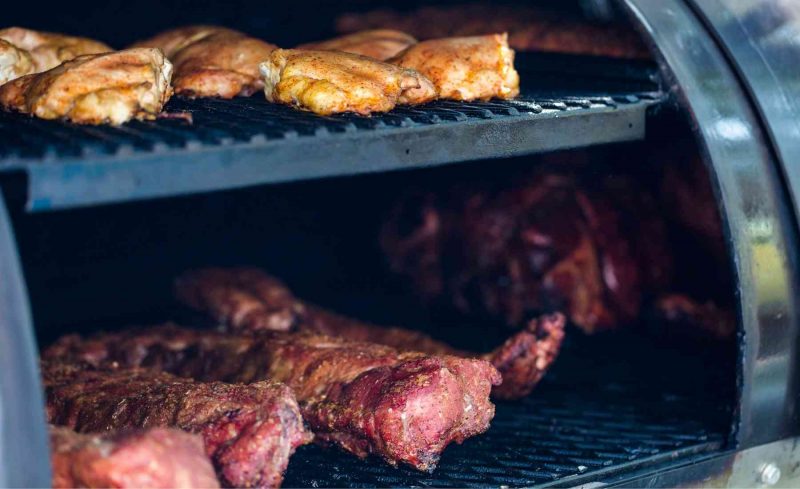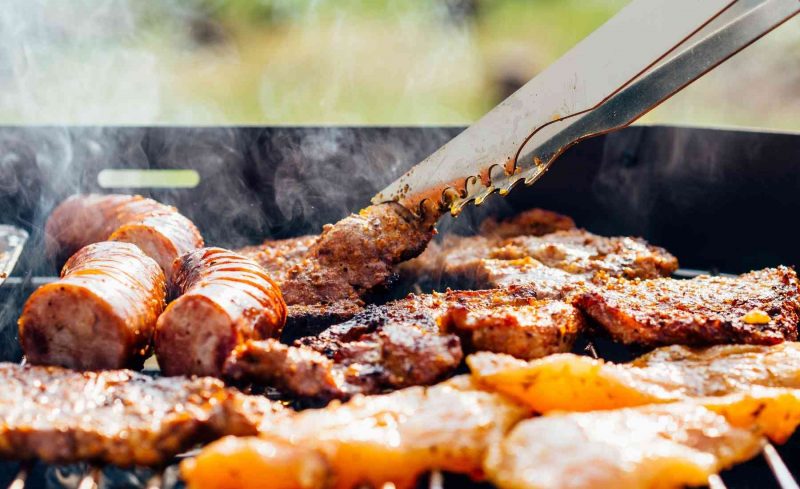Did you know that grilling and smoking are possible in cold weather? Many people think cold weather means they have to do all of their cooking indoors, but that is thankfully not the case. That’s why, today, I’m going to show you some tips for cold weather smoking & grilling. In fact, I’ve got 17 tips in total, ensuring that you will be well prepared the next time it’s chilly outside.
Let’s start with 7 smoking tips that I’ve compiled for your convenience. As you will soon discover, these tips bust a lot of myths surrounding smoking meat in the cold.
7 Tips for Cold Weather Smoking
As a certified fitness trainer and food enthusiast, I take pride in how I prepare my favorite dishes. If you’re as serious about your food as I am, you’re going to want to stick around. These 7 smoking tips will help you better understand how it works to ensure the perfect dish every time – even if it’s freezing outside!
#1 Know Your Smokers
Pitmasters know that different smokers produce different results, especially in cold temperatures. Smokers like Weber’s Kettle are designed with rather thin bodies. As such, it’s a lot harder to reach high cooking temperatures.
Not only that, but any temperatures you do reach are going to be lost a lot faster due to the thinner body. You will therefore need to burn more fuel just to maintain the right temperature. You can avoid this by investing in a smoker that is better insulated, such as a Kamado.
Thanks to thick ceramic insulation, it’s easier to maintain your desired temperature. Just keep in mind that because the insulation is thicker, it too will use more fuel to reach the right temperature. But once there, you can enjoy proper smoking without losing heat.
If you have a gas smoker, the same rules apply. A lot of people think gas can’t flow when temperatures are really low. However, that’s not the case at all. In order for propane to freeze, the outside temperature needs to be at least -44°F.
It’s safe to say, then, that most parts of the world aren’t going to have to worry about this being a factor in their smoking ventures.
#2 Improve Insulation
If you are concerned with the amount of insulation your smoker presently has, but you don’t want to spring for a new unit, you can make your own insulation to improve performance and reduce fuel costs.
Some crafty people have turned to furnace insulation or a welder’s blanket to achieve the right amount of smoker insulation. A welding blanket is ideal, as it gives your smoker additional protection from the outside elements. Wind, rain, sleet, and snow aren’t going to stand a chance. What’s more, you don’t have to worry about it accidentally catching fire.
If you want to be able to smoke your food in freezing conditions, furnace insulation will serve you well. Simply wrap it around your thin-bodied smoker and enjoy smoking in frigid temperatures. If you’d like to try these methods, you should be able to find everything you need from your local hardware store.
#3 Have Plenty of Fuel On-Hand
When smoking in cold weather, you’re going to use more fuel than usual. It’s just the nature of the matter. As such, you want to ensure that you have plenty of fuel, so you can avoid having to run to the store in the middle of smoking your food.
This includes charcoal, too. Stock up on a good bit of it, so you’re well-prepared for cold-weather smoking.
#4 Keep a Lid on It
Lifting the lid on your smoker causes your unit to work harder, which means it’s going to take longer to cook your food. In fact, a quick peek at your food can result in your smoker needing a couple more minutes to get back up to temperature.
This is true for warm days and especially true for colder ones. Therefore, you want to get into the habit of keeping your lid on while smoking your food. If necessary, create a canopy or umbrella of sorts to keep rain or snow from hitting your food when you do need to check on it. This also brings us to the next tip.

#5 Smoker Location
Oftentimes, cold weather is accompanied by wind, which can really put a damper on your outdoor smoking efforts. To ensure that this doesn’t become an ongoing problem, it’s important to place your smoker where it’s protected from wind and other elements.
Just make sure that the location you choose to position your smoker is open. You never want to use your smoker in an enclosed area like a garage or inside your house. Doing so puts you at risk of carbon monoxide poisoning.
#6 Consider Airflow
Your smoker needs to have consistent airflow. Too much airflow can lead to increased temperatures when you don’t need it, causing your food to overcook. Too little airflow is likely to result in the loss of heat.
To ensure that your smoker is getting the right amount of airflow at all times, you first need to locate its intake vents. If the outside wind is stronger one day, adjust your intake to prevent too much airflow from ruining your food.
Please keep in mind that it is always better to have the wind working in your direction, as stopping it completely will cause a significant drop in heat.
If you’re looking for the right smoker – check out these smoker grill combo reviews!
#7 Invest in a Jacket
If you want to be sure that your smoker has the best protection against the outside elements, consider investing in a smoker jacket. Different brands make jackets for specific smoker models, such as Weber’s Smokey Mountain.
You can also find some universal jackets, but you want to take measurements so you can be sure it is going to fit. Furthermore, you want to remember the airflow that we discussed above. Your smoker jacket needs to accommodate airflow, so make sure it matches up with your smoker unit.

10 Tips for Cold Weather Grilling
As with smoking, you can enjoy grilling out in the winter if you follow these handy tips. From basic cold-grilling etiquette to pre-grilling preparation, I’ve got you covered. When you make these tips habit, you’ll enjoy cold-weather grilling to its fullest potential.
#1 Dress for the Occasion
This might sound like a no-brainer, but it bears repeating. If you don’t have enough protection for yourself, you won’t be able to attend to your grill as required. Layer up accordingly, and you will be able to give your grill and your food the proper attention.
The last thing you want is to be running back and forth between your grill and your house. This will only serve to take time away from your food, thus increasing safety risks while detracting from your food quality.
Whether you’re making tailgating food or just cooking some burgers for dinner, dressing correctly is essential.
#2 Let Your Grill Warm-Up
Once the cold weather hits, it’s going to take longer for your grill to heat up. What might typically take 15 minutes to heat up in the summer is likely to take 30 minutes in the winter. As such, you need to allow ample time for your grill to reach the desired temperature.
Just be sure that you monitor your grill activity at all times. This is why it is so essential to bundle up before you go out. Firing up your grill and then going inside for several minutes sounds inviting, but you never want to take your eye off of the fire.
If something goes awry, you’ll be right there to remedy the situation safely. It’s worth noting that you should have a small fire extinguisher handy for such potentialities.
#3 Consider a Grill Cover
Just like a smoker, your grill needs protection from the outside elements. When installing a cover on your grill, take the time to seal it all the way around. When it comes time to use your grill, you’ll have a much easier time getting a fire going.
You also want to be sure to cover your grill when you’re not using it. Give it time to cool down, of course, but be sure to place that cover back over it when ready. Get into the habit of doing this each and every time you finish using your grill.
A cover will not only keep your grill protected, but it will prolong its lifespan, too.
#4 Remove Snow Often
No, snow doesn’t double as insulation. If you see that snow has accumulated on your grill, promptly remove it. Remember, snow is frozen water vapors. Water leads to rust. Rust leads to holes and other damage. And those holes in your metal lead to poor airflow and poorly grilled food.
Therefore, always keep an eye on your grill and remove snow as often as needed. This, too, will help extend the life of your grill so that you don’t have to replace it sooner rather than later.
Related: Infrared Grill Reviews for 2021
#5 Keep the Lid Closed
If you read the smoker tips, you may notice some recurring themes. But the same is true here, no matter how you look at it. Lifting the lid, even only occasionally, can affect the final product in your food. This becomes an even bigger problem in cold weather.
As such, you need to limit how often you’re flipping up the lid on your grill. Keeping all that heat trapped in will ensure faster, even grilling. Moreover, it will help to reduce your fuel consumption. If your grill has to work harder to reach the optimal grilling temperature, it will have to use more fuel to do so. Check out these grilling tips to help you become a master griller!
#6 Start Grilling Earlier
Unless there’s an unseasonably cold day, most cold-weather grilling is going to take place in the winter. And since the sun goes down earlier in the winter, you’re not going to have as much daylight to grill your food by.
If you don’t have a choice but to start later in the evening when it’s getting dark, make sure you have sufficient lighting set up around your grill. You have to be able to see clearly in order to grill your food to perfection.
If it’s necessary, you might want to install an outdoor lighting system just for your grilling area. It’s an added expense, sure. But you’ll be certain to have a premier grilling experience all year round.
#7 Consider Your Foods
Some foods grill up faster than others. If you’re not trying to be outside in the cold any longer than you have to, consider using foods that you know don’t take forever to make. A thick New York strip steak is going to take longer than a hamburger patty or if you’re trying to get the perfect bark on your brisket – this could take some additional time.
Therefore, you might want to save foods that require lengthy grilling for the spring and summer. This just happens to be the perfect segue into the next tip.
#8 Consider Food Maintenance
Foods that require constant flipping, basting, and other attention should be reserved for warmer weather. Remember, every time you open that grill lid to attend to your food, you’re allowing precious heat to escape while cold air blasts in.
You’re going to be fighting an uphill battle, with your food taking longer to cook. To that point, you should pick your foods wisely and avoid grilling anything that requires a lot of attention. This will help save on unnecessary fuel use, too.
#9 Choose a Safe Location
Cold weather means dead leaves and other debris scattered around your grill. As you have likely already surmised, this is a potential fire hazard. Therefore, your grill should be placed in a spot that is away from such risks.
Of course, this doesn’t mean grilling in the garage or in your kitchen. The rule of thumb is that you should place your grill no closer than 10 feet away from your home and other structures. This goes for loose debris, as well.
Setting up your grill too close to anything flammable puts you and your home in danger. Avoid this at all costs to ensure optimal safety conditions while you grill.
#10 Cover Your Food
As soon as your finished product comes off of the grill, it needs to be covered immediately. Doing so will ensure that the heat stays trapped inside rather than escaping into the cold outside air. Make it a habit to take finished food into the house right away, as well.
Depending on how much food you’re grilling, it might be better to have a friend or family member assisting you. Allowing them to handle finished food lets you focus on your grill, thus enhancing safety measures.
Final Thoughts on Smoking Meats in Cold Weather
You don’t have to let frigid temperatures prevent you from enjoying the food you love. Following these 17 helpful tips ensures that you’ll have safe smoking and grilling experiences in the cold weather. If you’re an avid do-it-yourselfer, you can build your own protection around your smoker or grill.
In doing so, you will be sure to get the most out of your cold-weather cooking. But above all else, be safe, and have fun!
